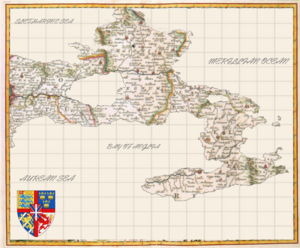History of Angland
Part of a series on the |
|---|
| History of Angland |
 |
The history of Angland dates to contact the pre-Remillian peoples of the Aurean coast of the Anglican Peninsula made with the Remillians and Carcedonians and the first writing systems known as Paleoanglican scripts were developed. During Classical Antiquity, the peninsula was the site of multiple successive colonizations of Remillians, Anglo-Herulians and Wittekings. Native peoples of the peninsula, such as the Robergiais people, intermingled with the colonizers to create a uniquely Anglican culture. The Remillians referred to the entire Peninsula as Angligaullica, from where the modern name of Angland originates.
Prehistory
Stone Age Anglica
Angland contains evidence of being the first in the western hemisphere to have been inhabited by humans, with the first traces of human life dating back to around 600,000 years ago, during the Great Hominid Migration. Continuous human habitation in Angland dates to around 13,000 years ago (see Wensley Man), at the end of the Last Glacial Period. This is commonly known by historians as the Old Stone Age, or Paleolithic Era. Evidence suggest what was to become Angland was colonised by humans long before the rest of the Anglican Peninsula due to it's hospitable climate and lack of apex predators. Evidence from caves suggest, however, that early humans in Angland had common contact with cave bears as damage to human and bear skeletons imply it was a commonality.
By 6500 BC, as in the rest of the world, was exclusively anatomically modern humans, and the evidence suggests that their societies were increasingly complex and they were manipulating their environment and prey in new ways, possibly selective burning of then omnipresent woodland to create clearings for herds to gather and then hunt them. Early Anglican hunters would use projectiles and slings to hunt. Bow and arrow was known in Eastern Parthenia since at least 9000 BC, however it took longer for it to reach Angland with earliest evidence being around 7000 BC. The climate continued to warm and the population probably rose.
Later Prehistory
Genetic Markers of Pan-Vetullian Culture
Early writing systems
Remillian Anglica
Anglo-Herulian Era
Initial Herulian Invasion/Migration
Religion
Witteking Invasions
1089 War with Vermand
House of Westemere
Stephen the Great
The Great Death
House of Orange
Emerging Romantic Culture
House Vieri and the Vieri Era
Treaty of Unity and the Anglish Empire
Arthur I
Fall and Civil War
Tommeni Era
His elder brother Eric died following a poisoning at his own wedding in 1695, leaving the throne empty to heir apparent Tommen. Despite not wanting to Tomen was placed onto a throne of glass, with both of his predecessors damaging the reputation of House Vieri. Tommen's age did not assist in this reputation as he was crowned aged 12 so those in the nation expected the worst from the young kind. Despite this, due to an ancient cultural tradition, he could not directly use all of his powers to rule until he was aged 15, so he would be given the choice to elect a council. The first member on his council was his grandfather Frederick Ecclestark who was renowned for his tactitional prowess. Another notable member of the council was Amalric Melisande, a Yerezhan man who was the first foreigner to serve on an Anglish Royal Council as well as Thomas Wells who served as almoner and cardinal of the catholic church, keeping relations with the Pope positive.
Upon the death of his brother his former wife, Lady Brianna of Priza, was left widowed. Brianna was bestowed to his brother upon birth as part of an arranged marriage to tie the monarchy of Vetullia with that of the Anglish crown, Brianna being the daughter of Charles VIII. Following the death of Eric, Charles wanted the money payed to Angland back as his daughter did not provide an heir to the former king. However Frederick Ecclestark, Tommen's grandfather, came to an agreement that Brianna would be given to Tommen as wife to make amends to Vetullia.
Tommen and Brianna were married at Eastminster Chapel in later 1695.
Conflict and Union with the Faith of the Nine
In June of 1696 Tommen's newly wed wife was imprisoned by a branch of the christian church known as the Faith of the Nine. The faith had a large and dedicated "cult" following, when Brianna was imprisoned the task of getting her back became a difficult one for the young king. She was charged by the Grand Sparrow, Petr Mertell, of committing 'sin' following a trial held during the Holy Inquest. It also found Tommen's mother, Allison Ecclestark, guilty of adultery. By the end of July in 1696 both were imprisoned at the Great Sept of Clarence in Retoria. This greatly upset young king Tommen as the two closest to him in life had been imprisoned and he had little he could do to free them due to the relationship between the Faith of the Nine and the Catholic Church in Cittasanta. It is alledged that his advisor (and grandfather) Frederick Ecclestark encouraged him to simply take them by force, liking it to Tommen's older brother Eric. Tommen refused and instead decided to form a union with the Faith of the Nine which meant that the release of his wife and mother was guarenteed.
This contributed to growing concerns that Tommen wasn't fit to rule Anglia, a sentiment which was beginning to grow in the north especially.


